Go to...  | Start A New Topic  | Search  | Notify  | Tools  | Reply To This Topic  |  |
Captain Doom |
Part 1: Research and Preparation Every Barth is different, but the headlight wiring should be straightforward. In this Part 1 procedure, I'll: 1. Lay out the tools and parts needed for the job. 2. Check the voltages at various points to determine if relays are warranted. If there are serious losses, then relays will be installed. (NOTE: Experienced techs know this, but losses occur only when current is flowing; one might measure satisfactory voltage with no load, but that reveals nothing.) 3. Trace the wiring to the high and low beam headlamps. First the tools and parts (Not shown is the red 10 ga., yellow and red 12 ga., and red and black 14 ga., stranded wire, and all the butt and spade connectors).  Clockwise from upper left: a. Circuit tester. This is handy because it has a sharp point to pierce wires to determine if power is present. The clip is connected to ground in our adventure, ~$10 b. Voltmeter. (actually, this is a "multimeter", which can also measure resistance, AC voltage, and small currents), ~$30-150 c. Contact Cleaner: Used to clean the headlamp connectors, ~$7 d. Terminal crimping tool: The stripper next to it also has a crimper section, but this crimper works far better, ~$15 e. Wire stripper, ~$5-10 f. Crimp connectors, blue for 14-16 ga wire, yellow for 10-12 ga. (estimated I'll use 4 10-12 1/4" spade terminals, 2 10-12 butt connectors, and 4 14-16 spades) g. 30A general-purpose relays, NAPA/Echlin AR274 (2 needed), ~$19 ea. Cheaper ones are available, but I don't like to re-fix things. 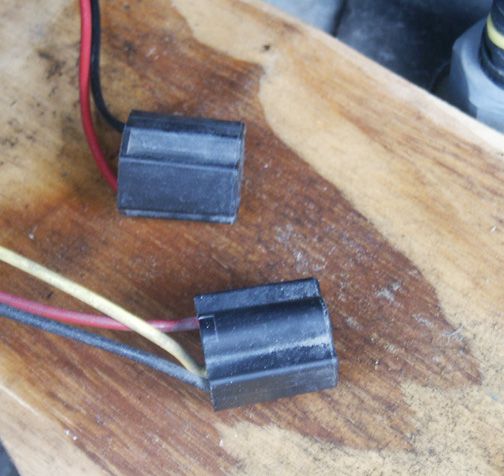 Headlight Connectors; these can be removed from behind the housings - no need to remove the headlamps. On mine, black and yellow are HOT, red is GROUND The 3-wire connector is for the outer (Hi-Lo) lamp, the 2-wire for the inner high only. Yellow is high beam, black is low on the 3-wire; black is high on the 2-wire. VOLTAGE READINGS:  Main Buss, high beams on: 13.11V 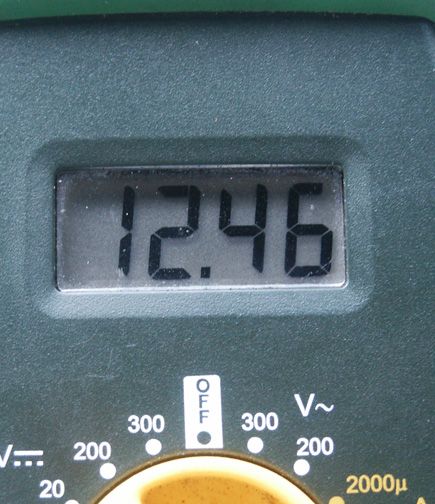 Headlight Switch Input, high beams on: 12.46V (0.55 V loss)  Headlight Switch Output, high beams on: 10.15V (2.3V loss)  Voltage at connector (yellow wire), low beam on, (one lamp): 9.89V (~0.25V loss) 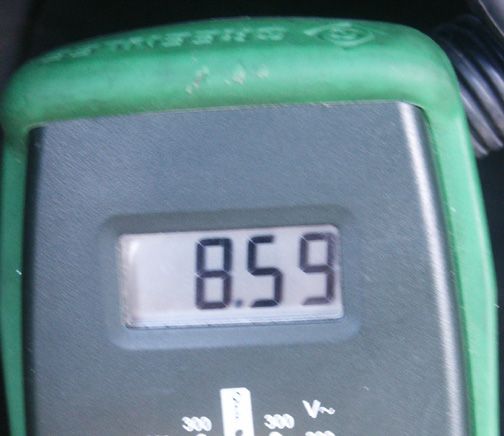 Voltage at connector (black wire), high beam on (three lamps): 8.59V (~1.5V loss) Progress so far: We've determined that there is a loss of 4.5V from the main buss to the headlights! This actually means the headlamps are getting less than 1/3 their rated power. (EDITED to correct price on the relays, $19 not $29) Part 2a: Locate Power Source; Prewire and Test Relays Step 4a.: Disconnect the converter from 120 VAC. Step 4b.: Disconnect the house battery. Step 4c.: With the voltage tester, find a "hot" terminal for supplying main power to the headlights. I can't help you here. 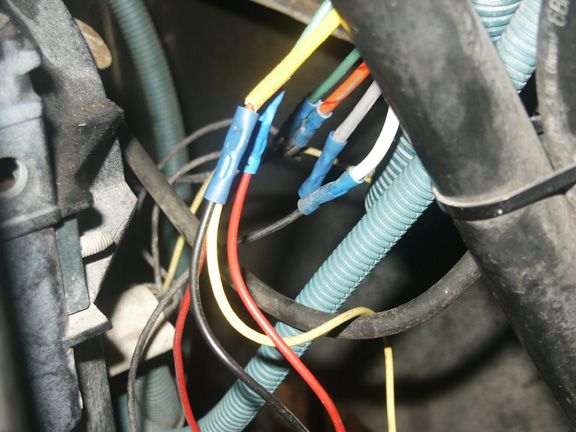 Step 5.: In this photo, the large yellow wire is for the high beams - it is connected to the yellow lead on the high-low beam lamp, and the black lead in the high-only lamp. The white wire (far right) is the low-beam supply - to the black on the high-low lamp only. With the headlights on, use your circuit tester to confirm the high- and low-beam supplies. Mark these, as in subsequent steps, they'll be connected to Terminal 86 (relay coil hot) on their respective relays. 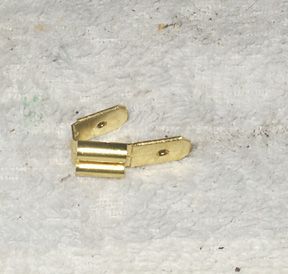 You will need a duplex connector (NAPA Assortment) OR a 6-8 female spade connector for the main supply to the headlights, and 3 fuse holders (at least 1 has to be 30A (NAPA 782-2023). 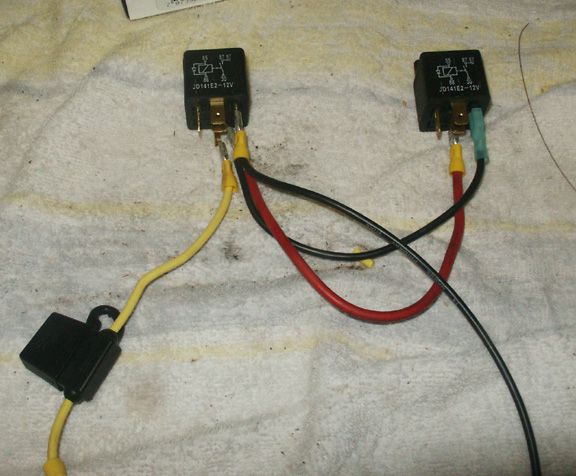 Step 6.: Make up the leads for the relays. The duplex connector was used to connect the 10 ga main power to relay #1 (Terminal 30), with its second connection used for the main supply (red wire) to relay #2. The yellow wire is for the fuse holder; a 30A blade fuse will be here. The end not seen is connected to the lead for the 12 VDC supply for the headlights (just visible is the butt connector for the lead). The black (14 ga.) wires are the ground leads for the relay coils. Both were crimped into a 10-12 ga. spade connector and attached to Terminal 85 on Relay #1, and then to 85 on #2. Test: Then, with 12 VDC, touch terminals 85 and 86 (the far left and right [black wire] in the photo). You should hear/feel the relay click. Part 2b, Install, Test and Connect Relays If you haven't done so already, disconnect the plugs from the headlamps. 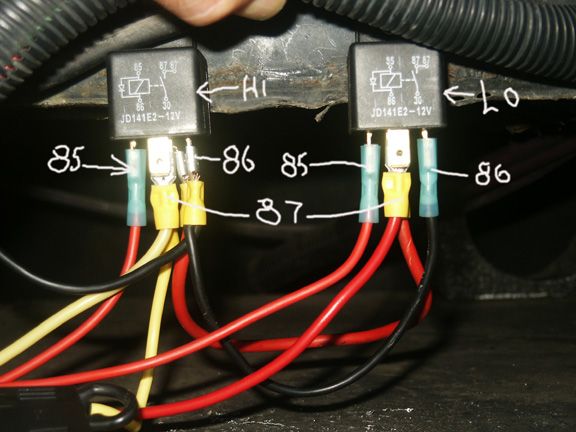 Step 7: I mounted the relays side-by-side on a convenient location on a firewall support. As a refresher, the relay terminals will be wired as follows: a. 30: Main supply, 10 ga fused wire to main 12 VDC supply from chassis battery. In this photo, the right-hand yellow is 10 ga to 30, which is hidden behind the 87s. b. 85: From existing wire to headlamp connectors; on mine, yellow is high beam, white, low. These are the two 14 ga red wires on the left side of each relay. c. 86: Ground, 14 ga black (16 ga ia OK), to a convenient grounding bar. d. 87/87: 12 ga to the headlamp connectors on each side. Only the right side has been connected, yellow to high, red to low. This relay was selected because it has 2x#87 terminals, making it convenient to connect to headlamps on each side. If yours is a relay with 87 and 87a, you'll need a duplex connector for each such relay as illustrated in Part 1. Step 8: (Headlight Switch OFF) a. Connect 86 to ground b. Cut the high or low beam supply at the existing butt connector. Set aside the headlamp plugs. Strip and butt splice the wire going to 85; crimp a spade connector on the end. Do not connect. c: Turn on headlights, make sure the correct beam is selected. d. Touch the new spade connector to terminal 85; you should hear the relay click; if it does, connect. e. Turn off the headlights f. Cut the butt connector off the headlamp plug wires, strip, and butt splice to 12 ga which will go to terminal 87. Crimp a spade connector onto the end and attach to terminal 87. g. Turn on the headlights; if low beam, you should have 12 VDC across the black and red of the three wire plug. If high beam, 12 VDC across the yellow/red of the 3 wire plug, and the same across black/red of the 2-wire. h. Turn off the headlights. i. Repeat the process for the remaining connections (1 for the other side for this relay, then both sides for the other relay. Step 9: Reconnect the headlamps and test the operation of the headlights. 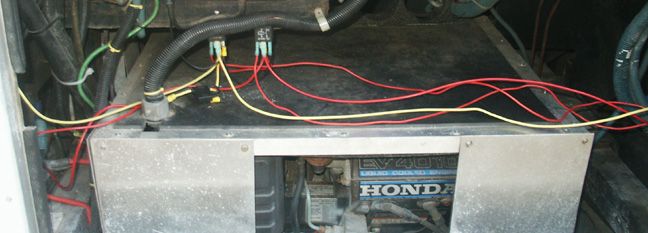 Here's what the whole system looks like completely wired. There is one major change in that I moved feed for the 85 terminals to the driver's side, because the passenger side was spliced in to that - best to avoid extra connections. 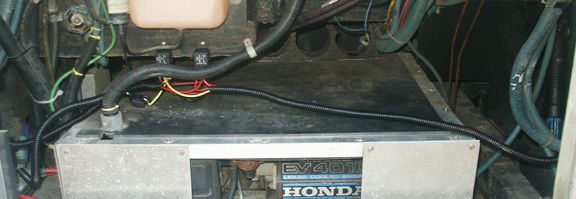 The wires are sleeved and ready to be secured - I left them loose until the wiper motors have been reinstalled. 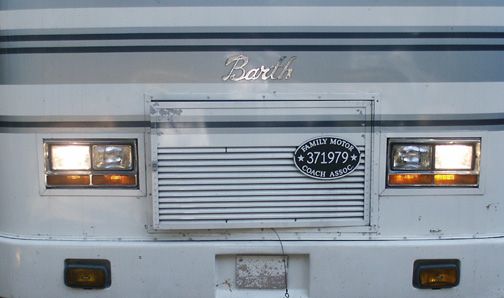  Tests successful. Voltage drop (Battery to headlamps) was ~3.5 VDC with the OEM wiring. It's now 0.16 VDC! Wiring Diagram courtesy of Bill N.Y.:  Rusty '94 28' Breakaway: MilSpec AMG 6.5L TD 230HP Nelson and Chester, not-spoiled Golden Retrievers Sometimes I think we're alone in the universe, and sometimes I think we're not. In either case the idea is quite staggering. - Arthur C. Clarke It was a woman who drove me to drink, and I've been searching thirty years to find her and thank her - W. C. Fields | ||
|
Guess you have found the headlight switch failure root cause. If head lights draw 10-15 amps with a 2.3 volt drop, there is 23-35 watts dissipated in the switch!! That is a lot! I am a bit surprised it is that much across just the switch. The loss you are measuring is very close to what I found on mine, but, I already had a high beam relay so high beams were good, the low beam is where I had the issue, adding the relay to the low beam circuit fixed all the low voltage and low output issues. I think most of the Breakaways had this issue. Ed 94 30' Breakaway #3864 30-BS-6B side entry New Cummins 5.9L, 375+ HP Allison 6 speed Spartan chassis K9DVC Tankless water heater | ||||
|
Captain Doom |
The designer of the switch (OEM for '82-94 Buick Centuries) was a magna cum laude graduate of the Rube Goldberg Institute of Bizarre Design. It even incorporated a bimetallic strip and a contact - apparently, the overheat issue was foreseen, and a thermal disconnect incorporated. Drilling the vent holes in the replacement switch keeps the temp down to 105°F; unvented, it ran up to 135°F+. Where DOES GM find these people? Late Note: In the first photo above you'll see alligator clips on (black) and near (red) the multimeter probes. For a buck these are useful accessories - crunch them down to fit the probes, and you can connect to things and not need three hands to get a reading. Rusty '94 28' Breakaway: MilSpec AMG 6.5L TD 230HP Nelson and Chester, not-spoiled Golden Retrievers Sometimes I think we're alone in the universe, and sometimes I think we're not. In either case the idea is quite staggering. - Arthur C. Clarke It was a woman who drove me to drink, and I've been searching thirty years to find her and thank her - W. C. Fields | |||
|
| First Month Member |
I wasn't part of the design team, but I'd bet the bimetallic strip was intended as a circuit breaker, to detect overload. Many manufacturers did incorporate an automatic circuit breaker into the light switch. I suspect many of the light switches are adequate for all the lighting loads involved on an RV. And a a toad or boat makes it worse. I have put a relay in mine for the tail/marker circuit as well as the headlights. . 84 30T PeeThirty-Something, 502 powered | |||
|
| First Month Member |
Sadly, many engineers are impractical, theoretical people, who have little contact with operational reality. The larger the organization, the more likely this is. I ran into this far more often in the airline industry than in light aircraft, for example. We (and every major base) had a whole crew of techs that did nothing but mods. That is, post-production band-aids ordered by the manufacturer, the airline or the FAA. There was always a giant backlog of work. As an engineering student, I attended a college that had two sides of the campus, engineering and A&P tech training. At that time, many students rode scooters or motorcycles. It was very revealing (even entertaining)to scrutinize the machines in the different parking areas of the dual campus. I have a good friend who had the highest GPA ever seen there, and ended up as a rocket scientist at NASA. He was such a tech guy that his tie bar was a miniature slide rule, and he always carried a 6 incher in his pocket, (no Mae West jokes here, please) And often a 12-incher on his belt. He was brilliant and incredibly well-informed in many, many areas, but hopelessly impractical. As skydivers, we each designed and built luggage racks for our parachutes on our motorcycles. He did all sorts of stress analysis, etc on his, and talked a really good game. He was farther ahead in the curriculum than I was, so I am sure he was doing it right from an engineering perspective. But, at the end, it was almost laughable, (even a girl friend could see the difference) and ignored the dynamics of motorcycle handling. You know, weight and balance, moment arm, center of gravity. It even had serious whip flex, which required the addition of a diagonal member and installation of an aftermarket steering damper. He has had a stellar career at NASA, though. I have an engineer cousin who grew up on a farm and was a tech before an engineer. He is a rara avis, a practical engineer. . 84 30T PeeThirty-Something, 502 powered | |||
|
| The Old Man and No Barth |
I still remember an episode a half-century ago when I was XO in a reserve unit of electronic techs. One of my guys who worked for a missile manufacturer came in to drill one night shaking his head, & cursing, "I told those SOB's, I told those SOB's." (He didn't abbreviate.) "Told 'em what?" I asked. He had told the engineers that interference in some electrical circuits would cause a major component to fail in the launch cycle of an Atlas missile. No way, they told him, they had designed those circuits. That day, in a test launch at Cape Canaveral, the engines lit off, the missile rose, the umbilical cord failed to detach, the emergency shut down worked, the engines shut off, the missile fell back on the pad, & blew itself & the launch pad to smithereens. It made a spectacular show on the evening news. I'm sure those engineers each made twice what my tech did, but they certainly weren't paid to take advice from a mere tech. But that's the way life is sometimes. | |||
|
 1/11 1/11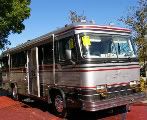 |
What would be the color of my ground and my hot wire?At least the head light is color coded green is to the frame. Would red still be ground in the light? lenny lenny and judy 32', Regency, Cummins 8.3L, Spartan Chassis, 1992 Tag# 9112 0158 32RS 1B | |||
|
Captain Doom |
You'll have to check that yourself, as I don't know if my headlight connectors are wired correctly. Rusty '94 28' Breakaway: MilSpec AMG 6.5L TD 230HP Nelson and Chester, not-spoiled Golden Retrievers Sometimes I think we're alone in the universe, and sometimes I think we're not. In either case the idea is quite staggering. - Arthur C. Clarke It was a woman who drove me to drink, and I've been searching thirty years to find her and thank her - W. C. Fields | |||
|
 1/11 1/11 |
I guess I will go with the red wire.I am working on the rear lights. thanks lenny lenny and judy 32', Regency, Cummins 8.3L, Spartan Chassis, 1992 Tag# 9112 0158 32RS 1B | |||
|
Captain Doom |
Part 2a: Locate Power Source; Prewire and Test Relays This post has been incorporated into the original entry Rusty '94 28' Breakaway: MilSpec AMG 6.5L TD 230HP Nelson and Chester, not-spoiled Golden Retrievers Sometimes I think we're alone in the universe, and sometimes I think we're not. In either case the idea is quite staggering. - Arthur C. Clarke It was a woman who drove me to drink, and I've been searching thirty years to find her and thank her - W. C. Fields | |||
|
Captain Doom |
Part 2b, Install, Test and Connect Relays This post has been incorporated into the original entry Rusty '94 28' Breakaway: MilSpec AMG 6.5L TD 230HP Nelson and Chester, not-spoiled Golden Retrievers Sometimes I think we're alone in the universe, and sometimes I think we're not. In either case the idea is quite staggering. - Arthur C. Clarke It was a woman who drove me to drink, and I've been searching thirty years to find her and thank her - W. C. Fields | |||
|
Captain Doom |
Wiring diagram has been inserted into lead post - thanks, Bill N. Y. Rusty '94 28' Breakaway: MilSpec AMG 6.5L TD 230HP Nelson and Chester, not-spoiled Golden Retrievers Sometimes I think we're alone in the universe, and sometimes I think we're not. In either case the idea is quite staggering. - Arthur C. Clarke It was a woman who drove me to drink, and I've been searching thirty years to find her and thank her - W. C. Fields | |||
|
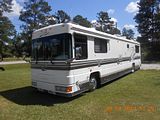 |
WHO WIRED THIS THANG!!!! Well, I finally got a round to installing the relays for the headlights that I bought months ago. Before I started the installation, I was going to measure the voltage drop on all the lights so I could measure the improvement. The more I messed with the lights, something just didn't look correct. Finally, I hung a sheet over a step ladder and placed it just in front of the lights on one side and then the other. It seems that for the last 17 years previous owners and myself have been driving around with a very unusual headlight arrangement. SOMEONE CROSSED THE HEADLIGHT WIRES. When the headlights were on low beam the outer lights were actually on high beam and the inner high beam lights were off. When the headlights were on high beam the outer lights were on low beam and the inner high beam lights were on. Of course the lights were so dim no one could tell the difference. Now they are wired correctly and nice and bright. Now just need to decide if I want to invest in some high powered seal beams. Anybody bought any they were really impressed with? Nick | |||
|
| 1st month member |
I would skip the sealed beams and buy HID's. They are comparable in price. 1999 Airstream Safari 25' 2007 Toyota Tundra 1987 Yamaha YSR toads | |||
|
Captain Doom |
HID kits for dual sealed-beam headlights run around $600. Rusty '94 28' Breakaway: MilSpec AMG 6.5L TD 230HP Nelson and Chester, not-spoiled Golden Retrievers Sometimes I think we're alone in the universe, and sometimes I think we're not. In either case the idea is quite staggering. - Arthur C. Clarke It was a woman who drove me to drink, and I've been searching thirty years to find her and thank her - W. C. Fields | |||
|
| Powered by Social Strata |
| Please Wait. Your request is being processed... |
|
This website is dedicated to the Barth Custom Coach, their owners and those who admire this American made, quality crafted, motor coach.
We are committed to the history, preservation and restoration of the Barth Custom Coach.
We are committed to the history, preservation and restoration of the Barth Custom Coach.

